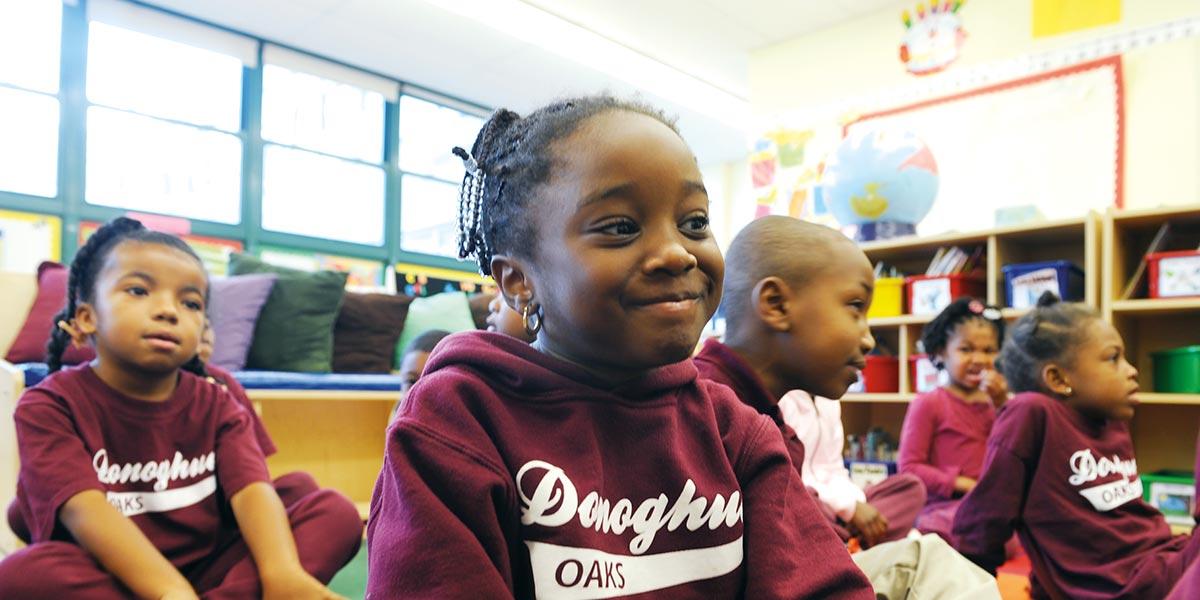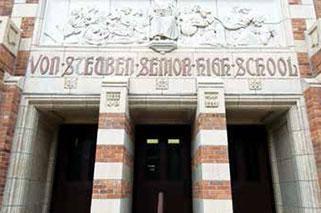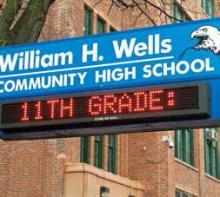Urban Education
VOLUME 24 | ISSUE 3 | FALL 2017
The institution of schooling shapes urban life arguably more than any other institution –especially in a city like Chicago, where issues such as policing, housing, employment, and segregation all find themselves bound up in one way or another with the question of educational equity.

Educators and researchers question the ever-prevalent school-to-prison pipeline, city leaders face segregated schools situated in segregated neighborhoods, and children do their best to cope as their parents struggle to find stable housing and employment. At SSA, our educational research looks beyond the notion of a “magic bullet” that will transform schools and instead searches for ways to bring together evidence, communication, distributed leadership, and an ethic of care to improve student outcomes, teacher practices, and school communities.
We strive to center the lived experiences and voices of those most vulnerable, the wisdom of educational practitioners, and a critical eye on those policies and practices that lead to unjust educational outcomes. Above all, we maintain a three-dimensional view of the people embedded in our research—not as “subjects,” but as people: children, adolescents, and adults, sometimes strong and sometimes vulnerable, embarking on pathways of learning. Research by Hermon Dunlap Smith Professor Melissa Roderick has focused on the link between high school freshman performance and graduation and dropout rates, while also building support systems for teachers and principals to share the most effective ways for using real-time data to support student achievement. Assistant Professor Shantá R. Robinson explains why building caring teacher-student relationships should be a core task of schools. And SSA’s Provost’s Career Enhancement Postdoctoral Fellow Eve L. Ewing helps us understand the role of racism in creating narrow evaluative criteria for successful schools, arguing that a broader conceptualization of a “good school” is especially important for schools serving African American children.
John Dewey, one of the most renowned and influential scholars of education ever to be affiliated with the University of Chicago, once wrote: “It is no accident that all democracies have put a high estimate upon education; that schooling has been their first care and enduring charge. Only through education can equality of opportunity be anything more than a phrase.” It is in this tradition that SSA education scholars not only extol the achievements of public education thus far, but insist that systems of schooling do more to ensure the success of every student. We strive to not only be critical engagers of our professional fields, but judicious community participators and worthy witnesses to the transformative power of education.
REFRAMING URBAN SCHOOL REFORM
Melissa Roderick has spent a career devoted to urban school reform, examining education policy and practices, and researching ways to enhance the quality of public education in the U.S. Roderick's urban school research, focused on the Chicago Public Schools (CPS), has led to new interventions, strategies, and partnerships that have improved graduation rates, reduced dropout rates, and helped create a pathway for young people aspiring to college, making a profound—and sustained—impact in the lives of thousands of young people.
Roderick’s research focused on the link between high school freshman performance and graduation and dropout rates. The transition between eighth and ninth grades, the research indicated, is a key intervention point in shaping students’ long-term outcomes. Ninth grade performance, Roderick found, is an important factor in keeping kids in school: if students stay “on-track” during their freshman year, they are almost four times more likely to graduate from high school than those who are off-track. Students are considered on-track if they have enough credits to pass to tenth grade, and have no more than one F in a core course.
Based on her research, CPS launched a major effort, using a Freshman On-Track system, which measures the progress of each student throughout the freshman year. Using real-time data of student progress, teachers focused attention on at-risk students—making calls to check on student absences, providing tutoring and homework assistance, or offering other supports to students and families—before students fell behind. And, Roderick’s research team found that when there’s an improvement in Freshman On-Track performance, the results are persistent and sustained—even after the freshman year. Research also indicated that staying on-track was an even stronger predictor of high school graduation than eighth-grade test scores and demographics, including poverty and race/ethnicity.
Roderick’s research dispelled a common assumption that drop-out was inevitable. Access to real-time data, focused attention, and increased supports to those students most at-risk during this critical development transition to high school could result in significant improvements in graduation rates. Districts across the country, including New York City, Dallas, Albuquerque, Omaha, and Philadelphia, now incorporate a Freshman On-Track indicator, and the associated supports to at-risk students, as part of their strategies.

HOW URBAN EDUCATION CAN LIVE UP TO ITS POTENTIAL
As an education scholar and former public school teacher, Shantá R. Robinson explores recurring questions concerning urban schools: Who is at risk in schools and what do race, gender, sexual orientation, and socioeconomic status have to do with it? Applying her interdisciplinary training in sociology, urban education history, and qualitative methodologies, Robinson examines how school and schooling problems are connected to issues of difference, sameness, and power. From the social organization of urban schools, to the exclusion of Black educators’ perspectives in educational history, to intragroup experiences of marginalized young people, Robinson’s research looks at the factors that contribute to achievement gaps and continued deficits in our urban education system.
Central to her work is the belief that any research that hopes to affect practice-based outcomes must focus on teachers—what they do, how they do it, and what the work of teaching means to them. Her foundational research showed that the quality of the teacher-student relationship was the primary factor in determining the educational experiences and achievement of Black and impoverished students. Students achieved higher test scores and grades when they were challenged in class, when those challenges were rigorous and tailored to their unique learning capabilities, and when they believed teachers cared about their promise and potential. All of these components are practicebased and can be modified by individual schools and teachers to positively impact every student.
While schools and schooling institutions have the power to help young people transcend their ascribed social locations and reach their aspirations, they also have the capacity to reproduce the social inequalities we witness in contemporary society. Robinson’s recent research with homeless adolescents explored these dueling aspects. Comparisons between homeless youth based on race and gender revealed marked differences in treatment by teachers, available resources and workforce training, and occupational aspirations. Black homeless adolescents often were offered lesser educational opportunities—thwarting upward mobility and increasing the likelihood of cycling repeatedly through poverty and homelessness. White homeless youth, however, were positioned to improve their economic conditions. With the proper guidance and will, schools can take steps to reverse these structural biases. Related to this work, Robinson recently led the Cook County qualitative component of Chapin Hall’s Voices of Youth Count, a national policy research initiative designed to identify the scope and scale of young people experiencing homelessness. The findings, gleaned from more than 200 interviews, have the potential to positively influence the services provided to Cook County homeless young people.
Her research, Robinson hopes, will directly help educators live up to the grand potential of public education: to find, support, and ignite the capabilities and promise of every student, irrespective of family background, neighborhood, or other circumstances. As a foundation to her work, she is refining an innovative theory of are, based on a restorative and equity-driven framework, which can be applied in urban schools. Such a restorative care approach, which Robinson is developing by building on prior theory and her own research, will foster and sustain constructive teacher-student relationships as part of the core curriculum of schooling. In so doing, care becomes not a precondition or source for the relationships between teachers and students, but a necessary outcome.

For almost as long as there have been schools in the United States, education in this country has been bound up with issues of race.
SCHOOLING (IN)EQUITIES
How do we know if a school is “good” or “bad”? Eve L. Ewing says it is much more complicated than simply looking at test scores or college acceptance rates, especially when making judgments about racially segregated schools serving African American children. As a former public school teacher, and now a poet, essayist, and scholar, Ewing is writing a deeper history of present-day public school performance in Chicago. Her work shows that for African American communities, schools are more than the sum of their performance metrics: they are living testaments to African American struggles for education, self-determination, and social justice in a nation that has long been hostile to these goals. Ewing calls us to learn and honor this history by imagining school quality along a different set of evaluative criteria.

For almost as long as there have been schools in the United States, education in this country has been bound up with issues of race. From the brutal boarding schools that took Native American children from their families and forbade them from speaking their indigenous languages, to the focus on American citizenship that was meant to assimilate Eastern and Southern European immigrants, to the battles over Brown v. Board of Education that spurred both great vitriol and great courage, schools have been sites of racial contention. Amidst the nation’s troubling history of discrimination and genocide, how can we still fight for the ideal that education can be, as Horace Mann famously put it, “the great equalizer”? In urban settings, this question is amplified further, as children from diverse backgrounds bring with them diverse needs, perspectives, and aspirations. Urban schools have the opportunity to narrow social divides—or, at our peril, widen them even further.
Ewing explores these issues in an upcoming book about the mass school closures in Chicago in 2013, which resulted in the displacement of thousands of African American children from their neighborhood schools. As the closings were being debated, public discord arose between community members alleging that the closures were racist, and district officials defending their actions as necessary given the depopulation of the city’s South and West Sides. Ewing tells the story of this contentious episode through the lens of the South Side community of Bronzeville.
She follows the public conversations there about school closure to unpack what African American teachers, students, and parents mean when they say school closures are racist. Ewing shows how these activists’ stance reveals their nuanced understanding of Chicago’s notorious history of segregation. They reject the idea that their schools are “bad,” and instead take the long view, marking the school closures of 2013 as yet another iteration of the racism that has driven policy decisions impacting African Americans from the 1940s through the end of the 20th century. Their narratives link school closures to these earlier policies—from restrictive covenants to the demolition of public housing—that denied African Americans self-determination. Ewing argues that the debate they raise about the nature of racism is illustrative of broader social tensions. Indeed, she writes that public officials are unlikely to make democratically accountable policy decisions as long as they fail to interrogate their own understandings of race and racism, and how that may conflict with community members’ understandings. Her work shows that what makes a school “good” or “bad” does not lie in a straightforward accounting of traditional school data. She reminds us instead that history, legacy, and family connections make many of these schools special and significant, even as they are under fire.
Next: How Prevention Research Can Short-Circuit Urban Problems